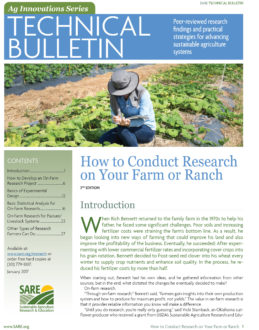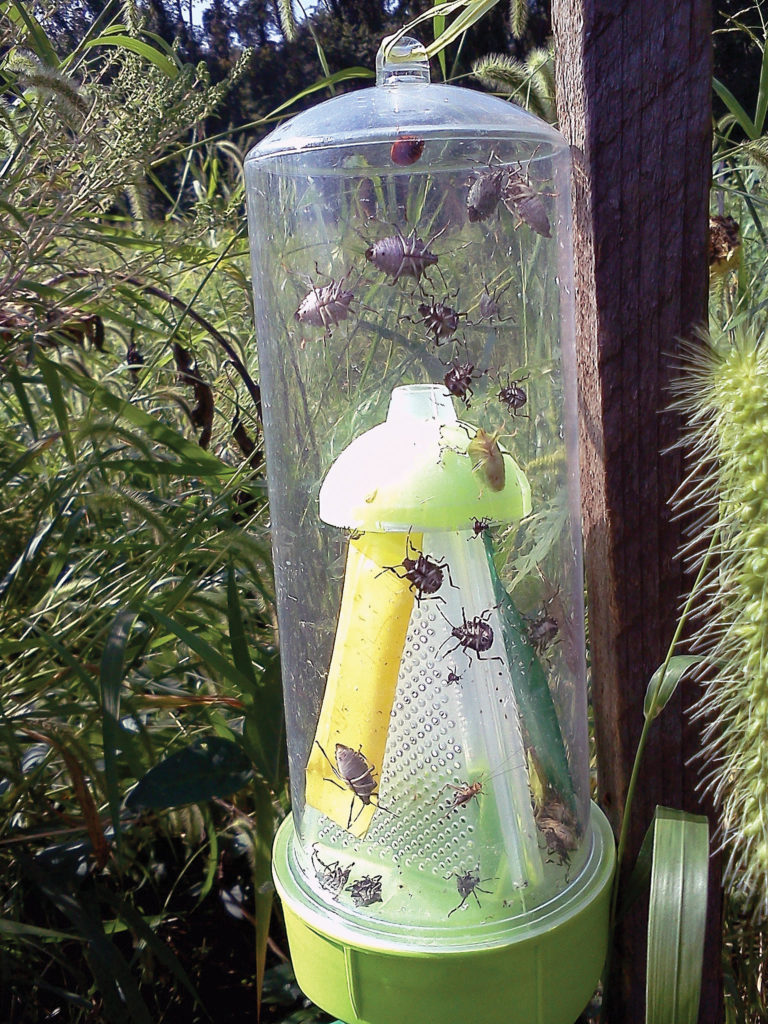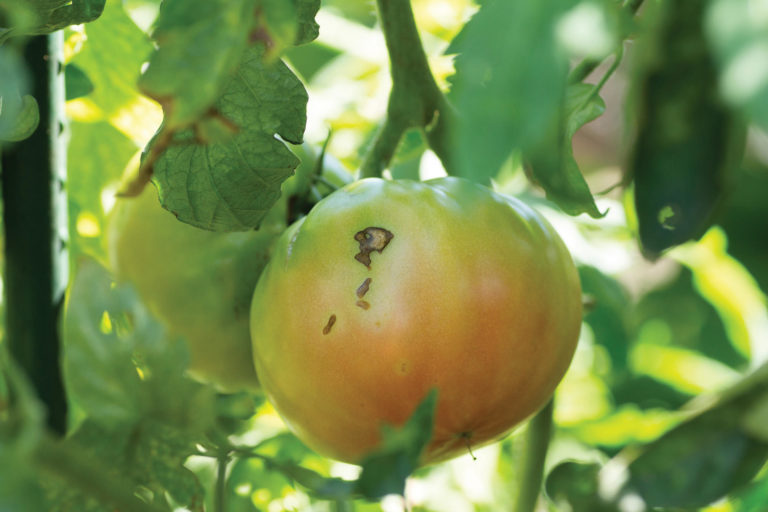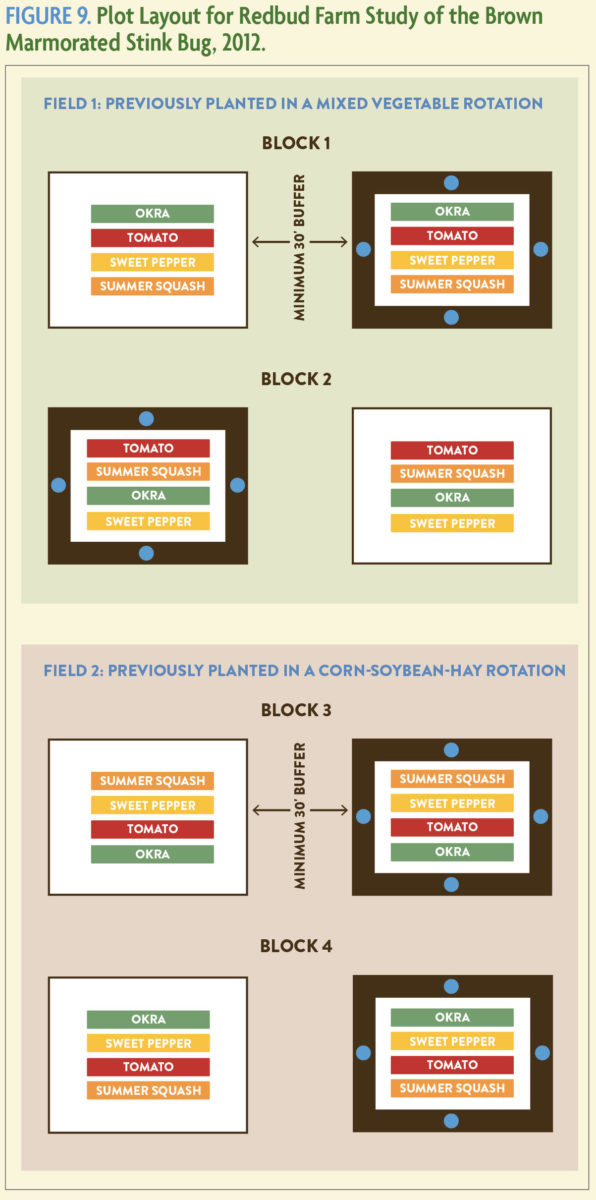Integrated Trap Crop and Pheromone Trap System for Organic Management of Brown Marmorated Stink Bug
Like many farmers in the United States, Clarissa Mathews is striving to manage the brown marmorated stink bug on her 50-acre farm in West Virginia. This stink bug feeds on a wide range of crops and has no native natural enemies, so the losses can be devastating. At Mathews’ Redbud Farm, stink bugs go through two life cycles in a growing season, with as many as 10 adults per tomato fruit. Annual losses from stink bugs at Redbud Farm have exceeded 30 percent of total revenues. Stink bugs are a major challenge for growers, and researchers and growers alike are struggling to develop effective control measures, especially ones that are ecologically sound.
Research Question/Objectives
Mathews identified a non-chemical approach to managing stink bugs that she thought might work on her USDA-certified organic farm—one that combined a perimeter trap crop with commercially available pheromone traps. But before she could implement this idea across the entire farm, she first needed to test it. Her basic research question was, “Is the new stink bug management strategy effective and economically feasible?” Specific objectives for this on-farm research project were to:
- Evaluate the effectiveness of the trap crop system in protecting four cash crops (i.e., stink bug densities on the cash crops, stink bug damage levels and crop yields).
- Determine the relative suitability (i.e., attractiveness) of species studied as trap-crop plants (green amaranth and sunflowers).
- Determine if stink bugs display directionality with respect to colonization of the plots.
- Determine stink bugs’ host-use preference with respect to the four cash crops studied.
Experimental Design
In 2012, Mathews evaluated the effectiveness of the “trap crop plus pheromone trap” technique in four cash crops with known susceptibility to stink bugs: okra, sweet peppers, tomatoes and summer squash. The research project used a randomized complete block design, with four blocks in two different fields. Each block consisted of two 900-square-foot plots: one with the trap crop and pheromone trap, and one plot without, to act as the control. Treatments were randomized within each block. Each plot consisted of four 36-foot rows, planted randomly to each of the four vegetable crops. For the treated plots, a trap crop of sunflowers and green amaranth was established in a 3-foot-wide perimeter around each plot, while stink bug traps baited with a chemical pheromone lure were placed on each of the four sides of the plot. All plots were planted at the same time and were managed in the same way on the same schedule throughout the growing season.
A schematic of the experimental design is shown in Figure 9. To test the effectiveness of the new technique, Mathews measured the following over the course of the growing season:
- The number of stink bugs (adults and nymphs) and egg masses in each type of vegetable crop.
- The number of stink bugs captured in the pheromone traps within the trap crop perimeters.
- Plant damage and crop yields for each crop type once they reached maturity, noting salable versus unsalable portions of fruit. Yield data was totaled by crop type across the season.
Statistical Analysis and Findings
Mathews first checked to make sure the data followed a normal distribution. Once that was confirmed, she used separate ANOVAs to evaluate stink bug densities by crop type, seasonal stink bug densities, crop damage levels, crop yields and other effects. Results of the experiment showed that stink bugs were highly attracted to the sunflower trap crop, with more than a two-fold increase in average stink bug densities in the trap perimeters, as compared to the cash crops. The trap crop perimeters also delayed stink bugs’ colonization of the cash crops, resulting in lower stink bug densities for tomatoes and peppers late in the season. However, reduced stink bug densities in the cash crops did not translate into significantly lower crop damage or higher yields in the trap crop plots as compared to control plots. Based on her results, Mathews concluded that the trap crop plus pheromone trap technique is effective for organic production, but will require a stink bug-specific pheromone lure or an organic mortality-inducing agent that can be incorporated within the trap crop perimeter in order to effectively reduce stink bug damage to the cash crops.
Project Team
Mathews has a doctorate in entomology from the University of Maryland, and her experience conducting field research projects is evident in this project. Farm manager Haroun Hallack is a former Extension agent in West Africa and has farmed organically for more than 15 years. Tracy Leskey, from the USDA Agricultural Research Service’s Appalachian Fruit Research Station, provided additional guidance and support.
LEARN MORE
For a complete description of this project, with results and data analysis, visit SARE's project reports database and see project FNE12-759.



